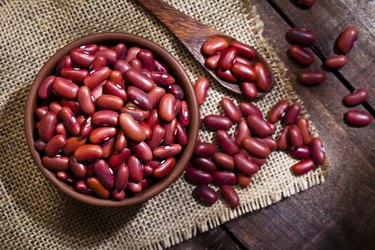
Protein is heavily associated with animal products like meat and eggs. However, plant-based sources of protein can be just as beneficial. While legumes, grains, nuts and seeds get most of the credit for being plant proteins, there are also high-protein vegetables and fruits.
Cooked vegetables and dried fruits tend to be the highest sources of protein from fruits and veggies. To get a lot of protein from these foods, you may need to consume larger quantities or have multiple servings throughout the day. Combine high-protein vegetables and fruits with other protein sources to maximize this nutrient.
Video of the Day
Video of the Day
Recommended Protein Intake
Protein is a vital nutrient with many important roles in the body. It is especially popular among fitness enthusiasts since protein helps build muscle mass. A diet that is moderate to high in protein is also linked to weight loss.
Because protein is so important, it is no surprise that most Americans get more than the recommended dietary allowance (RDA) for protein. According to the Physician's Committee for Responsible Medicine, most Americans consume approximately twice the amount of protein they actually need.
The USDA Dietary Guidelines recommend that adult women consume 46 grams of protein per day and men consume between 52 and 56 grams of protein per day depending on age. You can also calculate your protein requirements based on your body weight.
In the case of protein, more is not always better. It is possible to consume too much protein, which can have some negative side effects. Animal sources of protein also tend to be high in cholesterol and saturated fat. The USDA Dietary Guidelines recommend that teen boys and adult men decrease their intake of protein from meat, poultry and eggs. These groups can replace some animal products with veggies high in protein to still meet their nutritional goals.
Veggies High in Protein
Consuming veggies high in protein not only has the benefit of increasing your protein intake, but it also increases your consumption of other nutrients. Vegetables tend to be high in fiber, vitamins and minerals. They are also naturally low in calories and fat, making them diet-friendly foods.
According to the USDA, the top cooked veggies high in protein include:
- Green peas: 8.6 grams of protein per 1 cup
- Spinach: 5.3 grams of protein per 1 cup
- Asparagus: 4.3 grams of protein per 1 cup
- Brussels sprouts: 4 grams of protein per 1 cup
- Broccoli: 3.7 grams of protein per 1 cup
- Artichokes: 3.5 grams of protein per 1 medium artichoke
- Sweet corn: 3 grams of protein per 1 small ear
- Oyster mushrooms: 2.8 grams of protein per 1 cup
Fruit Sources of Protein
All foods can be broken down into the three macronutrients: protein, fat and carbohydrates. However, they tend to be higher in carbs than the other two. According to Harvard Health Publishing, both vegetables and fruits contain some protein, but the amount is usually smaller than other plant-based sources of protein.
Consuming the recommended amount of fruit per day may help you get closer to your daily protein goal.
According to the USDA, fruit sources of protein include:
- Jackfruit: 2.8 grams of protein per 1 cup
- Avocado: 3 grams of protein per 1 cup
- Dried apricots: 4.4 grams of protein per 1 cup
- Passion fruit: 5.2 grams of protein per 1 cup
- Dried plums: 3.8 grams of protein per 1 cup
- Raisins: 4.5 grams of protein per 1 cup
Eat More Plant Proteins
Adding high-protein vegetables and fruits into your diet is delicious, nutritious and easy. Cooking your vegetables allows you to eat more of them, which results in a higher amount of protein per serving. The best veggies high in protein are green peas and spinach, while fruit sources of protein mainly come from various tropical and dried fruits.
Even if you are not vegan or vegetarian, incorporating more plant-based sources of protein has the added benefit of being cholesterol-free and low in saturated fat. High-protein vegetables and fruits are also good sources of many nutrients, especially fiber.
- Physician’s Committee for Responsible Medicine: “Protein”
- USDA 2015-2020 Dietary Guidelines: “Nutritional Goals for Age-Sex Groups Based on Dietary Reference Intakes and Dietary Guidelines Recommendations”
- USDA 2015-2020 Dietary Guidelines: “A Closer Look at Current Intakes and Recommended Shifts”
- Harvard Health Publishing: “Protein”
- MyFoodData: “Nutrition Facts for Raisins”
- MyFoodData: “Nutrition Facts for Prunes (Dried Plums)”
- MyFoodData: “Nutrition Facts for Passion Fruit (Granadilla)”
- MyFoodData: “Nutrition Facts for Dried Apricots”
- MyFoodData: “Nutrition Facts for Avocados”
- MyFoodData: “Nutrition Facts for Jackfruit”
- MyFoodData: “Nutrition Facts for Oyster Mushrooms”
- MyFoodData: “Nutrition Facts for Cooked Yellow Sweet Corn”
- MyFoodData: “Nutrition Facts for Artichokes (Globe Or French) Cooked Boiled Drained With Salt”
- MyFoodData: “Nutrition Facts for Broccoli (Cooked)”
- MyFoodData: “Nutrition Facts for Brussels Sprouts (Cooked)”
- MyFoodData: “Nutrition Facts for Asparagus (Cooked)”
- MyFoodData: “Nutrition Facts for Cooked Spinach”
- MyFoodData: “Nutrition Facts for Cooked Green Peas”